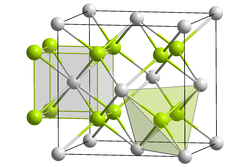 Rb+: __ Se2-: __ | |
| Names | |
|---|---|
| IUPAC name Rubidium selenide | |
| Identifiers | |
3D model (JSmol) | |
| ChemSpider | |
| ECHA InfoCard | 100.045.847 |
| EC Number |
|
PubChem CID | |
CompTox Dashboard (EPA) | |
| |
| |
| Properties | |
| Rb2Se | |
| Molar mass | 249.89 |
| Appearance | colourless, highly hygroscopic crystals [1] |
| Density | 2.912 g/cm3 [2] 3.16 g/cm3 [3] |
| Melting point | 733 °C [2] |
| hydrolyses [4] | |
| Solubility in other solvents | soluble in ethanol and glycerin |
| Structure | |
| cubic: antifluorite structure | |
| Hazards | |
| Occupational safety and health (OHS/OSH): | |
Main hazards | toxic |
| GHS labelling: | |
   | |
| H301, H331, H373, H410 | |
| Related compounds | |
Other anions | rubidium oxide, rubidium sulfide, rubidium telluride, rubidium polonide |
Other cations | lithium selenide, sodium selenide, caesium selenide, francium selenide |
Except where otherwise noted, data are given for materials in their standard state (at 25 °C [77 °F], 100 kPa). | |
Rubidium selenide is an inorganic compound composed of selenium and rubidium. It is a selenide with a chemical formula of Rb2Se. Rubidium selenide is used together with caesium selenide in photovoltaic cells. [5]
